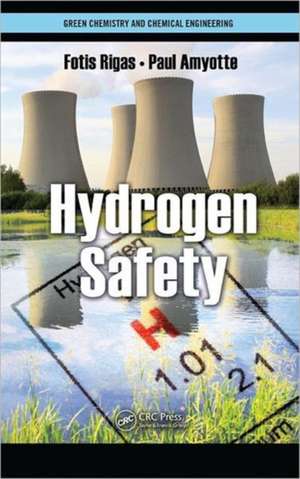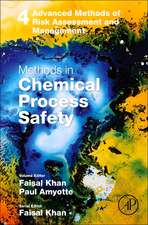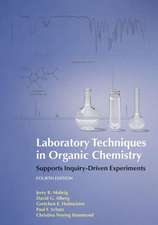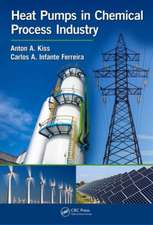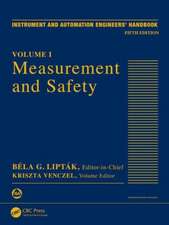Hydrogen Safety: Green Chemistry and Chemical Engineering
Autor Fotis Rigas, Paul Amyotteen Limba Engleză Hardback – 9 iul 2012
The number of potential applications for hydrogen continues to grow—from cooling power station generators to widespread commercial use in hydrogen fuel-cell vehicles and other fuel-cell applications. However, this volatile substance poses unique challenges, including easy leakage, low ignition energy, a wide range of combustible fuel-air mixtures, buoyancy, and its ability to embrittle metals that are required to ensure safe operation.
Focused on providing a balanced view of hydrogen safety—one that integrates principles from physical sciences, engineering, management, and social sciences—this book is organized to address questions associated with the hazards of hydrogen and the ensuing risk associated with its industrial and public use.
- What are the properties of hydrogen that can render it a hazardous substance?
- How have these hazards historically resulted in undesired incidents?
- How might these hazards arise in the storage of hydrogen and with its use in vehicular transportation?
Din seria Green Chemistry and Chemical Engineering
- 18%
 Preț: 849.40 lei
Preț: 849.40 lei - 18%
 Preț: 1336.46 lei
Preț: 1336.46 lei - 28%
 Preț: 1430.10 lei
Preț: 1430.10 lei - 15%
 Preț: 651.72 lei
Preț: 651.72 lei - 18%
 Preț: 700.75 lei
Preț: 700.75 lei - 30%
 Preț: 1016.94 lei
Preț: 1016.94 lei - 15%
 Preț: 508.10 lei
Preț: 508.10 lei - 31%
 Preț: 764.62 lei
Preț: 764.62 lei - 14%
 Preț: 1589.39 lei
Preț: 1589.39 lei - 18%
 Preț: 713.39 lei
Preț: 713.39 lei - 25%
 Preț: 496.94 lei
Preț: 496.94 lei - 18%
 Preț: 1590.61 lei
Preț: 1590.61 lei - 29%
 Preț: 1019.32 lei
Preț: 1019.32 lei - 30%
 Preț: 881.30 lei
Preț: 881.30 lei - 15%
 Preț: 459.74 lei
Preț: 459.74 lei - 18%
 Preț: 700.75 lei
Preț: 700.75 lei - 18%
 Preț: 700.75 lei
Preț: 700.75 lei - 15%
 Preț: 585.27 lei
Preț: 585.27 lei - 29%
 Preț: 524.78 lei
Preț: 524.78 lei -
 Preț: 463.30 lei
Preț: 463.30 lei - 15%
 Preț: 532.89 lei
Preț: 532.89 lei - 22%
 Preț: 370.25 lei
Preț: 370.25 lei - 18%
 Preț: 905.11 lei
Preț: 905.11 lei - 18%
 Preț: 700.75 lei
Preț: 700.75 lei - 18%
 Preț: 1319.09 lei
Preț: 1319.09 lei - 18%
 Preț: 788.77 lei
Preț: 788.77 lei - 26%
 Preț: 1101.47 lei
Preț: 1101.47 lei
Preț: 1347.52 lei
Preț vechi: 1480.79 lei
-9% Nou
Puncte Express: 2021
Preț estimativ în valută:
257.88€ • 268.24$ • 212.90£
257.88€ • 268.24$ • 212.90£
Carte tipărită la comandă
Livrare economică 14-28 aprilie
Preluare comenzi: 021 569.72.76
Specificații
ISBN-13: 9781439862315
ISBN-10: 1439862311
Pagini: 304
Ilustrații: 82 b/w images, 12 color images, 34 tables and N/A
Dimensiuni: 156 x 234 x 23 mm
Greutate: 0.57 kg
Ediția:New.
Editura: CRC Press
Colecția CRC Press
Seria Green Chemistry and Chemical Engineering
Locul publicării:Boca Raton, United States
ISBN-10: 1439862311
Pagini: 304
Ilustrații: 82 b/w images, 12 color images, 34 tables and N/A
Dimensiuni: 156 x 234 x 23 mm
Greutate: 0.57 kg
Ediția:New.
Editura: CRC Press
Colecția CRC Press
Seria Green Chemistry and Chemical Engineering
Locul publicării:Boca Raton, United States
Public țintă
Professional Practice & DevelopmentCuprins
Introduction. Historical Survey of Hydrogen Accidents. Hydrogen Properties Associated with Hazards. Hydrogen Hazards. Hazards in Hydrogen Storage Facilities. Hazards of Hydrogen Use in Vehicles. Inherently Safer Design. Safety Management Systems. HySafe: Safety of Hydrogen as an Energy Carrier. Case Studies. Effects of Hydrogen on Materials of Construction. Future Requirements for Hydrogen Safety. Legal Requirements for Hydrogen Safety.
Notă biografică
Fotis Rigas is Associate Professor, National Technical University of Athens, School of Chemical Engineering and has been a Visiting Professor at National Autonomous University of Mexico. His current research and academic activities are in the areas of process safety and bioremediation of contaminated sites. He has published or presented over 150 papers and book chapters in the fields of his activities and is a reviewer of papers in 36 international journals.
Paul Amyotte is a Professor of Chemical Engineering and the C.D. Howe Chair in Engineering at Dalhousie University in Canada. His research and practice interests are in the areas of inherent safety, process safety and dust explosion prevention and mitigation. He has published or presented over 200 papers in the field of industrial safety and is the Editor of the Journal of Loss Prevention in the Process Industries. He is also author of another CRC Press book, Process Plants: A Handbook for Inherently Safer Design, Second Edition (2010).
Paul Amyotte is a Professor of Chemical Engineering and the C.D. Howe Chair in Engineering at Dalhousie University in Canada. His research and practice interests are in the areas of inherent safety, process safety and dust explosion prevention and mitigation. He has published or presented over 200 papers in the field of industrial safety and is the Editor of the Journal of Loss Prevention in the Process Industries. He is also author of another CRC Press book, Process Plants: A Handbook for Inherently Safer Design, Second Edition (2010).
Descriere
This book highlights physiological, physical, and chemical hazards associated with hydrogen production, storage, distribution, and use systems. It also examines potential accidental scenarios that hydrogen may yield under certain conditions. The authors highlight hydrogen storage facilities because of the greater hazards encountered in them due to the increased quantities stored and handled, and on hazards resulting from the use of hydrogen as a fuel for transport. Computer simulations with the aid of computational fluid dynamics (CFD) of both gaseous and liquefied hydrogen are verified by experiments.
